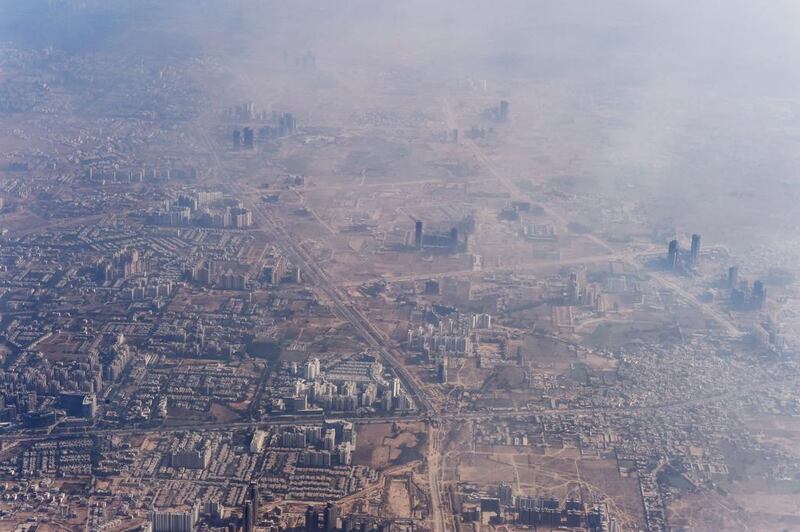NEW DELHI // In a bid to revamp its reputation as the city with the filthiest air in the world, the Delhi government on Sunday introduced a trial toll on lorries and other commercial cargo carriers that enter the metropolitan area.
The trial began two weeks before the festival of Diwali, when firecrackers erupt across the city in celebration, pouring more smoke into the already smoggy air.
The supreme court last month granted approval for the four-month trial, which will end in February. Light commercial vehicles will have to pay 700 rupees (Dh39.30) to enter Delhi, while heavier trucks and trailers will have to pay 1,300 rupees.
One owner of a small fleet of “tempos” – or light trucks – in the suburb of Gurgaon, speaking on the condition of anonymity, worried about paying the 700 rupees toll into the capital.
His vehicles haul furniture from showrooms that line the road from Delhi to Gurgaon, making deliveries to customers in the city. He was not sure as yet whether the toll would apply to him.
"The question is: Who pays the money?" he told The National.
“Will my showroom pay it, or will he pass it on to the customer? And if the customer has to pay, then maybe he’ll just start looking at furniture shops in the city itself, rather than pay this extra rate.”
Delhi does not allow commercial vehicles to ply on its roads during the day, but more than 50,000 light and heavy lorries enter Delhi between 8pm and 6am each day, according to the Centre for Science and Environment (CSE), a New Delhi-based non-profit.
“The legal principle on which this charge has been levied is the principle of ‘polluter pays’,” said Harish Salve, the supreme court lawyer whose petition prompted the October 12 order.
Taxing vehicles to tackle the problem makes economic sense. Anumita Roychowdhury, who heads the campaign for clean air at CSE, said that the most rapidly growing source of air pollution in Delhi is the city’s vehicles.
Delhi has more cars than Chennai, Mumbai and Kolkata put together, and 1,400 new cars are added to the roads every day.
“The problem of pollution is growing at a more rapid pace than our ability to control it,” Ms Roychowdhury said, adding that vehicle owners needed to pay “the real cost” of owning and using vehicles, in terms of tolls, taxes and parking charges.
But Nandikesh Sivalingam, a Greenpeace India campaigner, said the toll could only be a “temporary solution”.
Until now, lorries often drove through Delhi at night to avoid paying the tolls charged on the motorways that bypass the city.
Mr Sivalingam pointed out that trucks now detouring around Delhi to avoid its new toll would only be taking their pollution elsewhere.
The All India Motor Transport Congress, a body that represents the owners of roughly 8.7 million lorries and 200,000 private buses and light commercial vehicles, has not yet commented on the toll. But it has protested previous moves to increase tolls and taxes.
Delhi’s air has deteriorated alarmingly over the past decade. In May last year, the World Health Organization (WHO) declared that the Indian capital had the most polluted air in the world, outstripping even the notoriously noxious air of Beijing.
The WHO found an average concentration of 153 micrograms per cubic metre of fine particulate matter, compared with Beijing’s average of 56 micrograms. Known as PM2.5, these particles have been linked to health disorders such as bronchitis, lung cancer, respiratory ailments and heart disease.
By 2025, according to the Max Planck Institute for Chemistry in Germany, Delhi will have the world’s highest number of premature deaths caused by air pollution – with nearly 32,000 people dying annually.
When WHO released its rankings, Indian authorities called them misleading and insisted that Delhi was on par with Beijing. But the new toll is an implicit admission by the judiciary and the government that Delhi needs a fresh breath of air.
The situation turns particularly severe in the winter months.
“Cooler air settles close to the ground, and there’s a lot of moisture,” said Jatin Singh, the founder of Skymet, a private weather forecasting service. “And there’s no wind to blow the haze away.
“The haze days are arriving earlier and earlier every winter because of the number of vehicles and construction activity.”
ssubramanian@thenational.ae
* with additional reporting from Agence France-Presse





